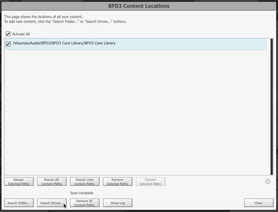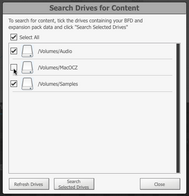Content Locations panel
|
If you're using BFD3 with only the BFD3 Core Library, the location to which the audio data was installed is already specified within BFD3 when it is launched. If you would like to use additional libraries or expansion packs with BFD3, they must first be added to the BFD3 Content Locations panel and scanned. To display the Content Locations panel, use the Set up content locations function in BFD3's Tools menu. Searching for additional content locations Before any additional content can be specified within BFD3, one or more content locations must be detected on your drive(s) by performing a search using the controls in the Search for content section of the Set up Content Locations dialog box. |
There are 3 ways to search for content locations:
|
Search a hard drive or multiple hard drives All drives on your system are shown, along with a checkbox indicating that it will be searched. Uncheck any drive(s) if required and then click the Search Selected Drives button. You can click the Search All checkbox to click the checkbox for all detected drives. Click the Refresh Drives button to refresh the list of detected hard drives in your system - you may need to do this after connecting an external disk, for example.
Specify a folder to search To search within a specific folder (and sub-folders within it), click the Search Folder... button to navigate to and select the desired folder. |
Drag and drop a folder onto the Content Locations panel
To proceed, search for valid content locations using the Search Drives... or Search Folder... buttons. Alternatively, a folder can be dragged from an OS file window onto the Content Locations panel to initiate a search within the folder.
Completing the process
|
The drive(s) or folder is searched for compatible data - this process can take a while so please be patient. Any folders which contain expansion packs usable within BFD3 are shown in the list of content locations along with the Core Library location. If its Activate box is checked, it is ready to use after clicking the Close button to exit the Content Locations panel. To avoid using any detected content location, simply deactivate its Activate box.
|
Additional Content Path functions
The main part of the Content Locations panel is a listing of the currently specified content locations (known as 'data paths' in previous versions of BFD).
A content location can contain 1 or more BFD-compatible libraries, presets, kits, key maps, grooves or other files. Use the Info display button to show a summary of the contents of each content location.
Activate
Each content location features a checkbox which activates it within BFD3. Uncheck the box to deactivate any path.
Activate All
Click the Activate All button to activate all paths currently listed.
Rescan Selected Paths
Click this button to rescan the data within the currently selected content paths. This may be required if any items have been manually deleted or added.
Rescan All Content Paths
This function rescans the contents of all currently detected content locations in the list.
Rescan User Content Paths
This function rescans the BFD3 user content locations within your Documents/BFD Drums/BFD3 folder, useful if any Presets or other files have been added manually. Note that the BFD3 user content location is not shown in the Content Locations panel listing.
Remove selected Path
This button removes the currently selected location in the list. The removed path does not reappear in the list until it is encountered by one of the search operations described earlier.
Add BFD2 Paths
This function can be used if an installation of BFD2 also exists on the system - all data paths (content locations) currently specified in BFD2's settings are read and added as BFD3 content locations. In addition, BFD2's system and user documents locations are also added as content locations so that all Presets and Kits available within BFD2 are also available in BFD3's Browsers.
Remove All Content Paths
This function removes all content locations currently shown in the list.
|
Show Log Click this button to display a separate log window containing a detailed report of any content location scans which can be useful for troubleshooting purposes. The log can be saved using the Save... button or by using the Copy to Clipboard button to paste into a separate document or email, while the Clear button empties the contents of the log buffer. Info display This display is hidden by default - its visibility is toggled by clicking the Info display button. When visible, it displays a summary of the contents of each selected path in the listing. |
Filters
The Filters menu is provided in case it is necessary to manage a very large number of data paths, as it allows the list to be filtered by various criteria to make management easier. By default it is set to Show all Paths - the following additional settings are available:
• Hide Disabled paths
• Hide Groove-only paths
• Hide Drum-only paths
• Hide Preset/Kit-only paths
If any data paths are hidden as a result of the current Filters setting, an alert is shown next to the Activate All button.
Close
Click the Close button to exit the Content Locations panel and return to the main BFD3 interface.
Authorizing additional expansion packs
If you are upgrading to BFD3 with BFD2 on the same system and your expansion packs are already authorized for use within BFD2, they do not need to be re- authorized for use in BFD3.
If they have not yet been authorized, they must be authorized in BFD License Manager at this point. Once it has been encountered during a BFD3 content scan, each expansion pack is inserted as a separate product into BFD License Manager.
Therefore, after scanning, launch BFD License Manager if it is not already running and authorize the expansion packs in the same way as you authorized BFD3.
Potential issues with content locations/data paths
If you are having problems with content not appearing within BFD3, please ensure the following:
Content location folder structure
•Each content location can contain either a /Data or /Audio sub-folder - not both.
•If any of your specified content locations features both a /Data and /Audio sub-folder, the easiest way to overcome the issue is to create a new folder elsewhere, move the /Audio folder to it, then add and activate the new folder as another content location within BFD3.
•If you are continuing to use BFD2 on your system to load older sessions, the new folder should also be added to your BFD2 data paths after which the BFD2 database must be rescanned.
•Users of the BFD Big Orchestral Marching Band expansion pack should be aware that its original installer offered a choice of installing to a BFD1 or BFD2 data path.
•If in any doubt regarding the above, please contact our support team who will be happy to assist you.
Check for all installed elements
Drums
Expansion pack content often contains multiple types of files which can be loaded, such as Presets, Kits, Kit-pieces (Drums) or Grooves. Not all expansion packs feature Kits and/or Presets so to conclusively verify whether the expansion pack has been installed and authorized, please make sure that its contained Drums exist in the Drums Browser. Use the Library Quick-filter menu in order to filter the Browser to only show the contents of the expansion pack.
Presets and Kits
All expansion packs which were released prior to BFD3 will feature only BFD2 and/or BFD1 Presets or Kits. If any such files exist in an activated content location, they are shown in BFD3's Presets and Kits Browsers.



